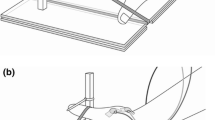Abstract
It has been suggested that a simple auditorily paced finger tapping task is associated with three tap-related neuromagnetic sources in the primary sensorimotor cortex contralateral to the tapping hand. Since a first source peaking at ~100 ms before tap-onset most likely represents activation of the primary motor cortex (M1) due to the motor command, a second source localized in the primary somatosensory cortex (S1) peaking around tap-onset could be due to kinesthetic feedback of the finger movement. A third source peaking at ~100 ms after tap-onset is also localized in the primary somatosensory cortex but inferior to the first S1 source (S1 inferior). The functional meaning of this source is still under debate. On the one hand it has been argued that S1 inferior represents the neuromagnetic correlate of tactile-kinesthetic feedback due to finger-taps and movements. On the other hand the functional meaning of this source could go beyond the sole processing of somatosensory feedback monitoring the temporal distance between tap and pacer (click) to keep the subject in time with the external event. This hypothesis is based on the observation that (1) S1 inferior seems to be coupled equally well to tap and click and (2) that this source might be triggered by the last event (i.e. tap or click). In the present study we re-examined this hypothesis by using a 122-channel whole-head neuromagnetometer. Eight healthy subjects synchronized their right index finger taps to an auditory pacing signal presented with a constant interstimulus interval of 800 ms. To test the hypothesis that the last event triggers S1 inferior we compared neuromagnetic activity following the tap as the first and the last event. In the auditorily paced finger tapping task usually the tap leads over the click (negative asynchrony). Therefore, the tap usually occurs as the first event. Since it has been shown that delivering additional feedback at the time of tap-onset results in a reduced negative asynchrony, in a second run auditory feedback was presented at tap-onset to enhance the number of positive asynchronies (i.e. the tap is the last event). Since no latency differences of S1 inferior associated with positive and negative asynchronies were found, results from the present study do not support the assumption that S1 inferior is triggered by the last event. Moreover, the amplitude of S1 inferior is significantly reduced following positive asynchronies as compared to negative asynchronies. Additionally, tap duration (i.e. the time between tap-onset and tap-offset) is significantly reduced while subjects produce positive asynchronies. Therefore, the amplitude of S1 inferior seems to be modulated by movement kinematics. This observation agrees well with the idea that activation of S1 is solely associated with the processing of somatosensory information. To conclude, our data contradict the hypothesis of an evaluation process localized in the primary somatosensory cortex and substantiate the idea that S1 inferior exclusively represents the processing of somatosensory feedback information.



Similar content being viewed by others
References
Aschersleben G, Prinz W (1995) Synchronization actions with events: the role of sensory information. Percept Psychophys 57:305–317
Aschersleben G, Prinz W (1997) Delayed auditory feedback in synchronization. J Mot Behav 29:35–46
Aschersleben G, Drewing K, Stenneken P (2002) Temporal coordination of simple movements. Cogn Proc 3:37–60
Gerloff C, Toro C, Uenishi N, Cohen LG, Leocani L, Hallett M (1997) Steady-state movement-related cortical potentials: a new approach to assessing cortical activity associated with fast repetitive finger movements. Electroencephalogr Clin Neurophysiol 102:106–113
Gerloff C, Uenishi N, Nagamine T, Kunieda T, Hallett M, Shibasaki H (1998a) Cortical activation during fast repetitive finger movements in humans: steady-state movement-related magnetic fields and their cortical generators. Electroencephalogr Clin Neurophysiol 109:444–453
Gerloff C, Uenishi U, Hallett M (1998b) Cortical activation during fast repetitive finger movements in humans: dipole sources of steady-state movement-related cortical potentials. J Clin Neurophysiol 15:502–513
Holm S (1979) A simple sequentially rejective multiple test procedure. Scand J Stat 6:65–70
Hommel B, Müsseler J, Aschersleben G, Prinz W (2001) The theory of event coding (TEC): a framework for perception and action planning. Behav Brain Sci 24:849–878
Kakigi R, Hoshiyama M, Shimojo M, Naka D, Yamasaki H, Watanabe S, Xiang J, Maeda K, Lam K, Itomi K, Nakamura A (2000) The somatosensory evoked fields. Prog Neurobiol 61:495–523
Kopp B, Kunkel A, Müller G, Mühlnickel W, Flor H (2000) Steady-state movement-related potentials evoked by fast repetitive movements. Brain Topogr 13:21–28
Lange R, Nowak H, Weiller C (2001) Passive finger movement evoked fields in magnetoencephalography. Exp Brain Res 136:194–199
Lee BI, Lüders H, Lesser RP, Dinner DS, Moris HH (1986) Cortical potentials related to voluntary and passive movements recorded from subdural electrodes in humans. Ann Neurol 20:32–37
Mates J, Aschersleben G (2000) Sensorimotor synchronization: the impact of temporally displaced auditory feedback. Acta Psychol 104:29–44
Müller K, Schmitz F, Schnitzler A, Freund H-J, Aschersleben G, Prinz W (2000) Neuromagnetic correlates of sensorimotor synchronization. J Cogn Neurosci 12:546–555
Pollok B, Müller K, Aschersleben G, Schmitz F, Schnitzler A, Prinz W (2003) Cortical activations associated with auditorily paced finger tapping. Neuroreport 14:247–250
Shibasaki H, Barrett G, Halliday E, Halliday AM (1980) Cortical potentials following voluntary and passive finger movements. Electroencephalogr Clin Neurophysiol 50:201–213
Acknowledgements
We would like to thank the participants for cooperation, Erika Rädisch for technical support during the MRI scans and Frank Schmitz for expert help during the MEG measurements. This study was supported by the Volkswagen-Stiftung (I/73240).
Author information
Authors and Affiliations
Corresponding author
Rights and permissions
About this article
Cite this article
Pollok, B., Müller, K., Aschersleben, G. et al. The role of the primary somatosensory cortex in an auditorily paced finger tapping task. Exp Brain Res 156, 111–117 (2004). https://doi.org/10.1007/s00221-004-1879-0
Received:
Accepted:
Published:
Issue Date:
DOI: https://doi.org/10.1007/s00221-004-1879-0




